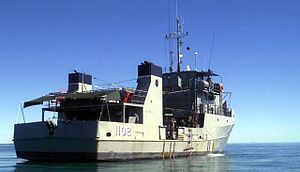
A minesweeper is a small warship designed to remove or detonate naval mines. Using various mechanisms intended to counter the threat posed by naval mines, minesweepers keep waterways clear for safe shipping.

HMAS Geranium was an Arabis-class sloop built in Scotland and launched in 1915. The ship was operated by the Royal Navy as a minesweeper from 1915 until 1919, when she was transferred to the Royal Australian Navy (RAN) for use as a survey ship between 1919 and 1927. The ship was decommissioned in 1927 and scrapped during 1932, with the remains scuttled in 1935.

HMAS Goulburn (J167/B243/A117), named for the city of Goulburn, New South Wales, was one of 60 Bathurst-class corvettes constructed during World War II, and one of 20 ordered by the British Admiralty but subsequently manned and commissioned solely by the Royal Australian Navy (RAN).

HMAS Kiama, named for the coastal town of Kiama, New South Wales, was one of 60 Bathurst-class corvettes constructed during World War II, and one of 36 initially manned and commissioned solely by the Royal Australian Navy (RAN).

HMAS Sydney was an Adelaide-class guided-missile frigate of the Royal Australian Navy (RAN). The frigate was one of six modified Oliver Hazard Perry-class frigates ordered from 1977 onwards, and the third of four to be constructed in the United States of America. Laid down and launched in 1980, Sydney was named for the capital city of New South Wales, and commissioned into the RAN in 1983.

HMAS Melbourne was an Adelaide-class guided-missile frigate of the Royal Australian Navy, which entered service in 1992. Melbourne has been deployed to the Persian Gulf on several occasions, and served as part of the INTERFET peacekeeping taskforce in 2000. On 26 October 2019, Melbourne was decommissioned from the RAN, subsequently being transferred to Chile. The ship was commissioned into the Chilean Navy as Almirante Latorre on 15 April 2020.

HMCS Glace Bay is a Kingston-class coastal defence vessel that has served in the Canadian Forces and Royal Canadian Navy since 1996. Glace Bay is the second ship of her class which is the name for the Maritime Coastal Defence Vessel Project. She is the second vessel to use the designation HMCS Glace Bay. She is assigned to Maritime Forces Atlantic (MARLANT) and is homeported at CFB Halifax.
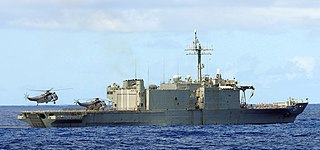
HMAS Kanimbla was a Kanimbla-class landing platform amphibious ship operated by the Royal Australian Navy (RAN). Originally built for the United States Navy (USN) as the Newport-class tank landing shipUSS Saginaw (LST-1188), the ship was decommissioned in 1994 and sold to the RAN.
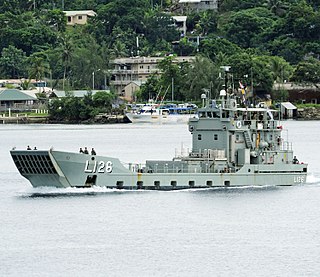
The Balikpapan class is a ship class of eight heavy landing craft. All eight were originally laid down by Walkers Limited for the Australian Army in the early 1970s. A reorganisation of watercraft responsibilities in the Australian military meant the landing craft were to be operated by the Royal Australian Navy (RAN), with seven commissioned directly into RAN service during 1973 and 1974, and lead ship Balikpapan transferred from the army to the navy. During the leadup to the independence of Papua New Guinea in 1975, two of the vessels were transferred to the new Papua New Guinea Defence Force (PNGDF).

The Ton class were coastal minesweepers built in the 1950s for the Royal Navy, but also used by other navies such as the South African Navy and the Royal Australian Navy. They were intended to meet the threat of seabed mines laid in shallow coastal waters, rivers, ports and harbours, a task for which the existing ocean-going minesweepers of the Algerine-class were not suited.
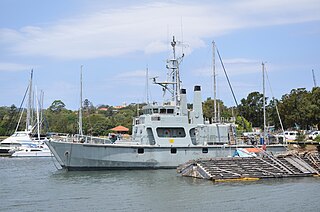
The Bay-class Minehunter Inshores were a class of catamaran-hull mine warfare vessels operating with the Royal Australian Navy from 1986. Also referred to as the MHCAT, the class was an attempt to produce a locally designed inshore mine warfare vessel. Two prototype ships were ordered in 1981, with the first ship, Rushcutter, commissioned in November 1986. The two ships experienced delays in construction, and the RAN resorted to acquiring six minesweeper auxiliaries (MSA) under the Craft of Opportunity Program to provide an interim mine-warfare capability, while also keeping Ton-class minesweeper HMAS Curlew in service until 1990, well beyond her intended decommissioning date. The ships did not enter service until 1993, due to problems with the sonar.
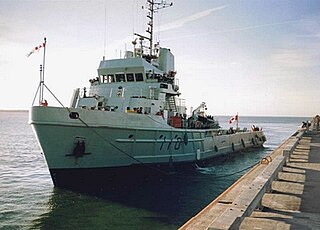
The Anticosti-class minesweepers were a class of minesweepers that served with the Canadian Forces from 1989–2000. The class consisted of two former oil rig supply vessels, Jean Tide and Joyce Tide. They were acquired by Maritime Command (MARCOM) and commissioned in May 1989 with Jean Tide becoming HMCS Anticosti (MSA 110) and Joyce Tide becoming HMCS Moresby (MSA 112). Once the Kingston-class coastal defence vessels became operational, the Anticosti class was discarded and the two ships returned to mercantile use.

HMCS Anticosti was an Anticosti-class minesweeper that served in the Canadian Forces from 1989 to 2000. Originally an oil rig support vessel, she was purchased in 1989 and saw service until the entry of the newer Kingston-class coastal defence vessels. The ship was named for Anticosti Island, the second to bear the name. Following her Canadian naval career, Anticosti was sold to commercial interests.

HMAS Goorangai was a 223-ton auxiliary minesweeper of the Royal Australian Navy (RAN). She was built in 1919 for the Government of New South Wales, then sold in 1926 to the fishing company Cam & Sons. The trawler was requisitioned for military service following the outbreak of World War II, converted into a minesweeper, and assigned to Melbourne. She was sunk in an accidental collision with MV Duntroon in 1940, becoming the RAN's first loss of World War II, and the first RAN surface ship to be lost in wartime.

The Craft of Opportunity Program (COOP) was a Royal Australian Navy (RAN) acquisition program intended to supplement the navy's mine warfare capability with civilian vessels that could be quickly converted into minesweepers. Vessels acquired under COOP were not commissioned into the RAN, and instead operated with the prefix "MSA".
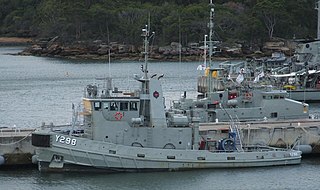
The Bandicoot class was a ship class of two minesweeper tugboats operated by the Royal Australian Navy (RAN). MSA Bandicoot and MSA Wallaroo were built in 1982 for Maritime (PTE) Ltd. as the tugboats Grenville VII and Grenville V. In 1990, the RAN purchased the vessels for conversion into auxiliary minesweepers under the Craft of Opportunity Program (COOP). The vessels could be equipped with a sidescan sonar and various towed minesweeping arrays, and also functioned as berthing tugs. Both vessels were placed in reserve in 2010, but were deployed on several occasions since to provide berthing support to nuclear-powered warships. They were removed from naval service in 2014.
Two ships of the Royal Australian Navy have been named Brolga, after the brolga.
HMCS Moresby was an Anticosti-class minesweeper that served in the Canadian Forces from 1989 to 2000. She was named for Moresby Island, which in turn is named for Fairfax Moresby, former Commander-in-Chief of Pacific Station at Esquimalt Royal Navy Dockyard. Prior to her acquisition by Canada, Moresby served as the offshore supply vessel Joyce Tide, built by Allied Shipbuilders of Vancouver, British Columbia. Joyce Tide was acquired by the Canadian Forces for conversion to a minesweeper and as a training ship for naval reservists. With the entry into service of the Kingston-class coastal defence vessels, Moresby was sold to commercial interests, returning to her previous career. The ship was renamed several times, most recently Ramco Express in 2007.

HMCS Thunder was a Bangor-class minesweeper constructed for the Royal Canadian Navy during the Second World War. The minesweeper entered service in 1941 and took part in the Battle of the Atlantic and the invasion of Normandy. Following the war Thunder was sold for scrap and broken up.
HMCS Gaspé was a Bay-class minesweeper that was constructed for the Royal Canadian Navy during the Cold War. The vessel entered service in 1953 and remained with the Royal Canadian Navy until 1958. That year, the ship was transferred to the Turkish Navy and renamed Trabzon. The vessel remained in service until 1991.
